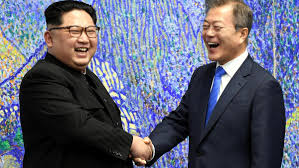Koreans from both the South and North, divided by mines invested borderline and ideology eased signs of relieves on Friday as leaders of the two countries embraced each other for the first time in many decades.
North Korean leader Kim Jong Un and South Korean President Moon Jae-in not only pledged to work for the complete denuclearization of the Korean peninsula, but also agreed to open liaison offices and also allow Korean families divided by the border to meet.
The two Koreas announced they would work with the United States and China this year to declare an official end to the 1950s Korean War and seek an agreement to establish “permanent” and “solid” peace in its place.
The declaration included promises to pursue phased military arms reduction, cease hostile acts, transform their fortified border into a peace zone, and seek multilateral talks with other countries including the United States.
Their dramatic meeting comes weeks before Kim is due to meet U.S. President Donald Trump in what would be the first ever meeting between sitting leaders of the two countries.But there was widespread scepticism about whether Kim is ready to abandon the nuclear arsenal his country has defended and developed for decades as what it says is a necessary deterrent against U.S. invasion.
It’s not the first time leaders of North and South Korea have declared their hope for peace, and two earlier summits, in Pyongyang in 2000 and 2007, failed to halt the North’s weapons programs or improve relations in a lasting way.
“We will make efforts to create good results by communicating closely, in order to make sure our agreement signed today before the entire world, will not end as just a beginning like previous agreements before today,” Kim said after the agreement was signed.
The United States is hopeful talks will make progress on achieving peace and prosperity, the White House said in a statement as the two men began their summit.
Just months ago, Trump and Kim were trading threats and insults as the North made rapid advances in pursuit of nuclear-armed missiles capable of hitting the United States.
Impoverished North Korea and the rich, democratic South are technically still at war because the Korean War ended in a truce, not a peace treaty.
The United States stations 28,500 troops in South Korea as a legacy of the Cold War conflict, which pitted the South, the United States and United Nations forces against the communist North, backed by China and Russia.

 Latest3 days ago
Latest3 days ago
 Latest5 days ago
Latest5 days ago
 News2 days ago
News2 days ago
 Energy6 days ago
Energy6 days ago
 Latest4 days ago
Latest4 days ago
 Comments and Issues6 days ago
Comments and Issues6 days ago
 Business6 days ago
Business6 days ago
 Business6 days ago
Business6 days ago

